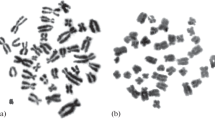Summary
Cytogenetic studies based upon somatic cells (bone marrow) have disclosed that the marmot hitherto designated Marmota caligata broweri Hall and Gilmore, occurring in the Brooks Range of arctic Alaska, differs from M. c. caligata (Eschscholtz) in number of chromosomes (2n=36 as compared with 2n=42 in M. caligata) and in proportions of chromosomal types. Typical karyograms for the two species are presented. It is concluded that the Brooks Range marmot is specifically distinct from M. caligata, the applicable name being Marmota broweri Hall and Gilmore. Also determined were diploid chromosome numbers for two other Nearctic species of marmots, M. flaviventris (Audubon and Bachman), with 42, and M. olympus (Merriam), with 40. It is suggested that M. broweri survived the last (Wisconsin) glaciations in the amphi-Beringian refugium, and that its closest affinities may be with one of the Eurasian species of Marmota.
Similar content being viewed by others
Literature
Conger, A. D., and Lucile M. Fairchild: A quick-freeze method for making smear slides permanent. Stain Technol. 28, 281–283 (1953).
Couser, W., P. Sargent, L. E. Brownhill, and K. Benirschke: The somatic chromosomes of the Northeastern American woodchuck, Marmota monax. Cytologia (Tokyo) 28, 108–111 (1963).
Dalquest, W. W.: Mammals of Washington. Univ. Kansas Publ., Mus. Nat. Hist. 2, 444 p. (1948).
Ellerman, J. R., and T. C. S. Morrison-Scott: Checklist of Palaearctic and Indian Mammals 1758 to 1946, 810 p. London, Brit, Mus. (Nat. Hist.) 1951.
Hall, E. R., and K. R. Kelson: The Mammals of North America, vol. 1, 546 p. N. Y.: Ronald Press 1959.
Howell, A. H.: Revision of the American marmots. N. Amer. Fauna No 37, 80 p. (1915).
Moore, J. C.: The spread of existing diurnal squirrels across the Bering and Panamanian land bridges. Amer. Museum Novitates No 2044, 26 p. (1961).
Nadler, C. F.: Chromosome studies in certain subgenera of Spermophilus. Proc. Soc. exp. Biol. Med. (N.Y.) 110, 785–788 (1962).
—, and M. H. Block: The chromosomes of some North American chipmunks (Sciuridae) belonging to the genera Tamias and Eutamias. Chromosoma (Berl.) 13, 1–15 (1962).
Rausch, R. L.: On the status of some arctic mammals. Arctic 6, 91–148 (1953); - Origin of the mammalian fauna of the Kodiak Archipelago. In: The Kodiak Island refugium, its geologic and biologic history. Ed. T. Karlstrom et al. (1965).
Author information
Authors and Affiliations
Rights and permissions
About this article
Cite this article
Rausch, R.L., Rausch, V.R. Cytogenetic evidence for the specific distinction of an Alaskan marmot, Marmota broweri Hall and Gilmore (Mammalia: Sciuridae). Chromosoma 16, 618–623 (1965). https://doi.org/10.1007/BF00326977
Received:
Issue Date:
DOI: https://doi.org/10.1007/BF00326977




